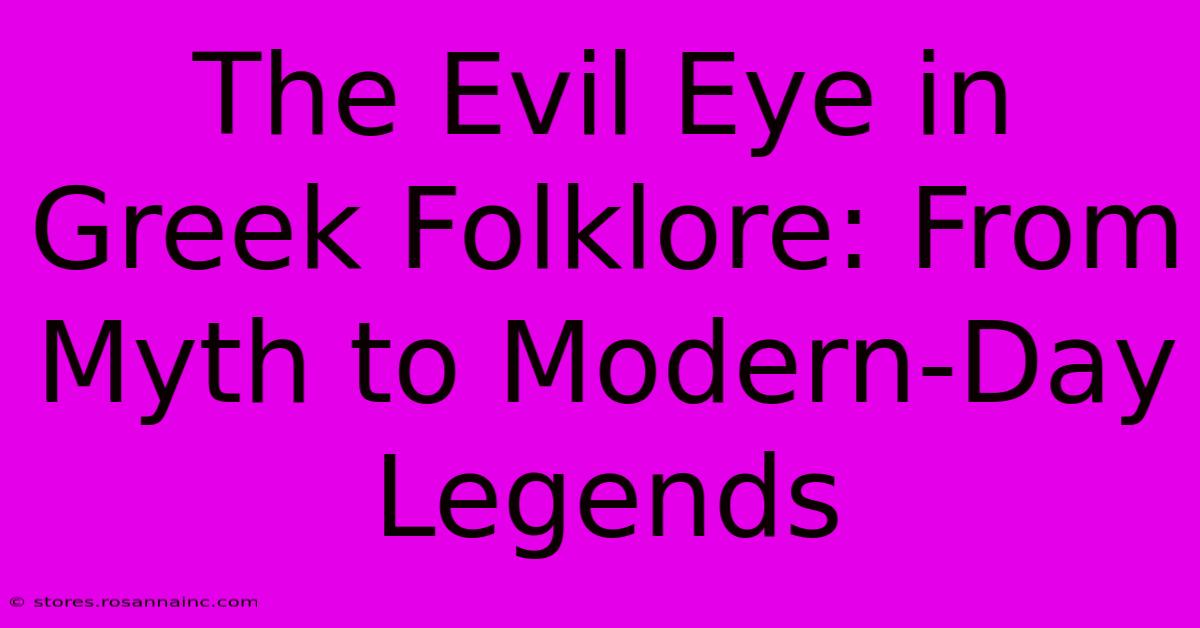The Evil Eye In Greek Folklore: From Myth To Modern-Day Legends

Table of Contents
The Evil Eye in Greek Folklore: From Myth to Modern-Day Legends
The "mati" (μάτι), or evil eye, holds a powerful place in Greek folklore, a potent force capable of inflicting misfortune, illness, or even death. Its influence stretches far beyond ancient myths, weaving its way into modern-day beliefs and practices, a testament to its enduring presence in Greek culture. This article delves into the fascinating history and enduring legacy of the evil eye in Greece.
The Origins of the Mati: Ancient Beliefs and Myths
The concept of the evil eye isn't unique to Greece; it's found in cultures worldwide. However, its presence in Greek mythology and folklore is particularly strong. While there isn't one singular origin myth, the power is often associated with envious glances. Ancient Greeks believed that individuals possessing a strong, malevolent gaze could unintentionally (or intentionally) unleash harmful energy upon others, causing a range of negative consequences. This belief is deeply rooted in the ancient world’s understanding of unseen forces and the power of the human spirit.
The Gaze of the Gods: Connecting Mythology to Belief
Some scholars link the evil eye to the power of the gods themselves. The gods, with their immense power, could bestow blessings or curses with a mere look. This divine power, interpreted through a human lens, could have contributed to the development of the belief in the power of the human gaze to inflict harm. The fear of attracting unwanted attention, even from the gods, may have strengthened the cultural significance of protection against the evil eye.
Manifestations of the Evil Eye: Recognizing the Signs
The effects of the evil eye weren't always immediately apparent. Symptoms could manifest subtly, such as unexplained illness, bad luck, or a sudden downturn in fortune. In more extreme cases, the victim might suffer severe illness or even death. Recognizing the signs was crucial, as early intervention was believed to be essential in mitigating the harm.
Identifying Victims: Who is Vulnerable?
Children, particularly infants and young children, were considered especially vulnerable to the evil eye's effects. Their innocence and perceived vulnerability made them easy targets for negative energy. People experiencing a period of good fortune or success were also at risk, as envy was considered a primary catalyst for the evil eye's power. The sudden onset of unexplained illness or misfortune often served as a key indicator that the evil eye was at play.
Combating the Evil Eye: Protective Amulets and Practices
Throughout Greek history, various methods have been employed to protect against the evil eye. These range from simple gestures to intricate amulets and rituals.
The Power of the "Mati": Protective Amulets
The most recognizable symbol of protection is the "mati," a small, blue glass amulet often shaped like an eye. This amulet is believed to deflect the evil eye's gaze, absorbing the negative energy directed towards the wearer. These charms are ubiquitous in Greece, appearing on keychains, jewelry, and even displayed in homes and businesses.
Other Protective Practices: From Rituals to Gestures
Beyond amulets, Greeks traditionally utilize other protective measures. The "psitos," a spitting gesture accompanied by a verbal incantation, is a common way to dispel the evil eye's effect. Likewise, certain gestures, such as crossing oneself or making the sign of the cross, are also employed to ward off negative energy.
The Evil Eye in Modern Greece: A Persistent Belief
Despite advancements in science and technology, the belief in the evil eye persists in modern-day Greece. While its influence may not be as dominant as in previous centuries, it remains an integral part of the cultural fabric. The ubiquitous presence of the "mati" amulet, the continued practice of protective rituals, and the prevalence of stories about the evil eye are all testaments to its enduring legacy.
The Evil Eye and Tourism: A Cultural Icon
Today, the evil eye has transcended its purely protective function, becoming a recognizable symbol of Greek culture. Tourists often purchase "mati" amulets as souvenirs, inadvertently contributing to the globalization of this ancient belief. This increased visibility has further cemented the evil eye’s place in the global cultural imagination.
Conclusion: An Enduring Legacy
The evil eye in Greek folklore represents a powerful blend of myth, superstition, and cultural tradition. From its ancient origins in mythology to its continued presence in modern-day Greece, the "mati" continues to exert a significant influence on the lives of many Greeks. Its enduring legacy serves as a compelling reminder of the enduring power of belief and the fascinating ways in which culture shapes our understanding of the world around us. The evil eye is more than just a superstition; it's a deeply ingrained cultural element that continues to shape the lives and beliefs of people in Greece.

Thank you for visiting our website wich cover about The Evil Eye In Greek Folklore: From Myth To Modern-Day Legends. We hope the information provided has been useful to you. Feel free to contact us if you have any questions or need further assistance. See you next time and dont miss to bookmark.
Featured Posts
-
Autumns Whispering Song Let The Colors Guide Your D And D Adventure
Feb 06, 2025
-
Unveil The Secrets Decoding The Bunting Manufacturers Color Code Symphony
Feb 06, 2025
-
Black Friday Social Media Domination The Winning Strategies For Explosive Reach
Feb 06, 2025
-
Indulge In Fontastic Delight Tt Chocolates Demibold Now At Your Fingertips
Feb 06, 2025
-
Glitter Galaxy Overload How Dnd Gel Polish Transforms Nails Into Celestial Wonders
Feb 06, 2025
